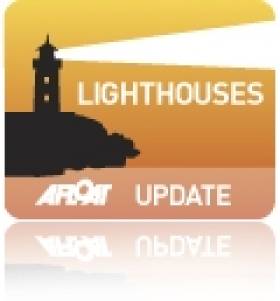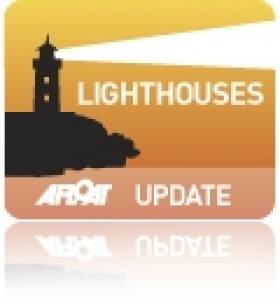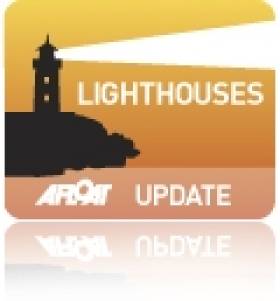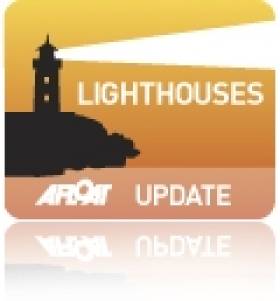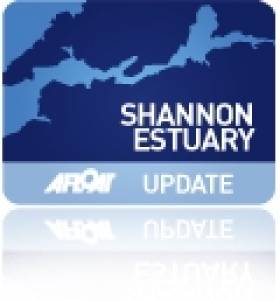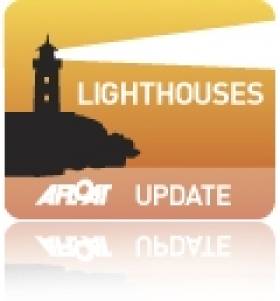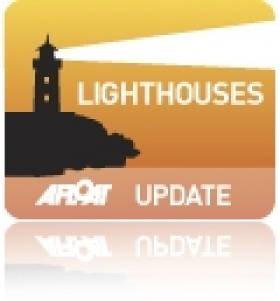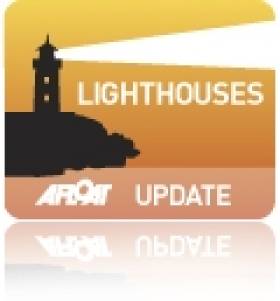Displaying items by tag: Irish Lights
#dlharbour – Hostile questions were asked in the Dail on Wednesday by local TD Richard Boyd Barrett on the proposed development of Dun Laoghaire Harbour as a cruise liner port. They were deflected in ministerial replies about legislation currently being drafted, and the two possible viable ways forward for the harbour's administration. But the underlying pace is accelerating towards a resolution of the future of this unique example of Victorian design, engineering and construction. W M Nixon finds that, in recent days and weeks, his views on the possible uses of this magnificent artificial harbour have undergone considerable change.
Embarrassment is a powerful stimulant for change. Change of attitude, change in ways in behaving, change in ways of looking at things, change to entrenched ways of thinking. I was hugely embarrassed by something seen in Dun Laoghaire nine days ago. And within seconds, there came a complete epiphany, with the sudden awareness that an entrenched attitude towards the development of Dun Laoghaire as a cruise liner port had turned through about 140 degrees.
It made for the complete 180 degrees, as the first 40 degrees of the turn had already been achieved a couple of weeks previously, while spending two completely absorbing if mentally exhausting hours with the maverick Alistair Rumball and his team at the Irish National Sailing School beside the inner recesses of Dun Laoghaire's inner harbour, which is still called the Coal Harbour even though it's very many years since anyone offloaded any lumps of the black gold there.
Be that as it may, as we parted we were shooting the breeze about the proposed development of Dun Laoghaire as a cruise liner port, which has been top of the local agenda since the end of March, and handily gave us one of our choicer April Fool's Day stories here on Afloat.ie - it proved so effective we had to add a health warning.
When a story provides you with something like that, you develop a certain affection for it. So while Alistair and I agreed that that the absolute dream solution for Dun Laoghaire Harbour would be a top-of-the-line government-funded National Monument Preservation Scheme, with the entire place given over exclusively to recreation afloat and ashore, and no commercial shipping of any significant size whatsoever allowed about the place, we knew it was pie in the sky.
"How on earth would they really pay for it?" he asked. "This place is huge, it costs a fortune to run and maintain. A cruise liner berth offers the best and most compact method of providing a worthwhile income stream. And as we in our sailing school – being a commercial operation – have to be rigorous in observing harbour regulations and keeping clear of the established in-harbour shipping lanes, we know that you can continue to sail small boats in large areas of the harbour without any undue sense of space restrictions".
Subsequently, I've been spending some time around Cork Harbour, where circumstances are so different from Dublin Bay that, unlikely as it may seem, you end up feeling sorry for the sailors of south Dublin. For while Cork is almost embarrassed by its riches in natural amenities for sailing, and it's all in a large and attractive harbour where marinas can be put down almost anywhere with no more than a floating breakwater to provide the necessary minimum of shelter, Dublin Bay by contrast is a hugely deprived area in terms of natural waterfront facilities for sailing, yet any attempts to provide man-made shoreline amenities for boats and sailors are dogged with local opposition every inch of the way.

Around Cork Harbour, it only needs a floating breakwater and, hey presto, you've suddenly got a marina - as seen here at Monkstown. Photo: W M Nixon
Thoughts of this struggle, and how things change, emerged again for various reasons in Dun Laoghaire nine days ago, at the reception in Irish Lights HQ to launch the Great Lighthouses Tourism Initiative. Time was when our many fine lighthouses were places of mystery, and permission to visit took quite a bit of arranging if it could be managed at all. But my word, times have changed. In this electronic age, there are those who wonder if we need all our lighthouses. Yet Irish Lights is legally obliged to maintain them, and the built structures around them.
So Yvonne Shields, the CEO of Irish Lights, whom we'd describe as very switched on and extremely bright were we not talking of the top executive in a lights organisation, unveiled this sensible scheme whereby twelve of our greatest lighthouses are being transformed into stations on a tourist trail, while continuing as working lighthouses.
As the greatest and most monumental lighthouses on land tend to be on rugged headlands in remote areas, in the eyes of Brussels they're in peripheral areas deserving special aid. So there's €2 million of Eurodosh going into this project, which sees what had become increasing liabilities being transformed into tourist resources. And if we're going to be sniffy about that, let's face it: the kind of tourist who'll want to visit a remote lighthouse will not be the kind of tourist who would keep you well clear of Temple Bar.
So the old grey matter was churning briskly away on the business of seeing lighthouses in a new way as we headed home past the Coal Harbour, and there it was: The Embarrassment. For this was the evening at the end of the day when the majestic and rather handsome cruise liner Queen Mary 2 was anchored off Dun Laoghaire in a near gale from the southwest which had delayed the morning's arrangements to ferry passengers ashore in the ship's own tenders to the special landing pontoon installed by the Harbour Company in the inner harbour.
By this time, they were trying to return on board, waiting patiently in a queue which ran the length of the inner pier and more as the two ship's tenders bustled the mile and a half plus out to the ship, yet still more buses turned up to disgorge more passengers, such that for a while the long length of the queue seemed to stay persistently the same.
Perhaps it's because we Irish don't do queuing that I found the entire thing acutely embarrassing to behold. And it wasn't even as if it was raining, which it well could have been. Nevertheless it struck me as being a Third World sort of scenario. Yet obviously these people were keen to visit Dun Laoghaire – most of the thousands of passengers on board had elected to go ashore.

This just won't do at all – images of Third World destinations came to mind on seeing the passengers from the Queen Mary 3 queuing in the Coal Harbour in Dun Laoghaire to get back out to their ship anchored in the bay. Photo: W M Nixon
So the epiphany came with the essential flashing great light. If we're going to have cruise liners calling at Dun Laoghaire, boomed this disembodied voice, then let's do it properly and provide them with a proper berth. Otherwise, don't have them about the place at all. But please, please – no more buzzing in and out in little tenders in this Irish climate, and no more queuing on a comfortless pier. It's an affront to our best traditions of hospitality.
This sudden firing-up with all the zeal of the recent convert (for until then, I'd wanted Dun Laoghaire to stay exactly as it is, and damn the expense) resulted in my being right into the dragon's den four days later. It was meant to be a short and businesslike meeting with Gerry Dunne, the CEO of Dun Laoghaire Harbour Company, to discuss the Cruise Liner Berth Proposals. But so many ideas were flying around that we ran well over time.
Please be assured, though, that I did my best to represent the needs of the boat-owning and sailing community while accepting that since Stena Sealink withdrew from running a ferry service from Dun Laoghaire to Holyhead, something very serious indeed needs to be done to pay for the maintenance of the harbour.
We have to remember that, among Ireland's main sailing centres, Cork and Kinsale are blessed with such good natural harbours that any marinas located in either harbour do not need fixed breakwaters. As for Bangor Marina on Belfast Lough, it may need a very substantial solid breakwater on its north side, but otherwise - thanks to being located in a bay - three of its four sides are naturally sheltered. But Dun Laoghaire is badly done by – it's so totally an artificial harbour in an exposed location that three of its four sides are protected by large man-made breakwaters, and while they are constructed in monumental style, continuous monitoring and maintenance is essential.
This is costly, but it would become even more so were standards allowed to slip for even a year or two. Even with the present high standards, there can be underlying wear and tear which in time needs major capital expenditure, and according to one recent report, hidden erosion on the most exposed section of the East Pier may eventually need up to €5 million for a proper remedial job.
As it is, the current basic running costs of the harbour are between €2 and €2.5 million a year. Were it kept as a purely recreational harbour and general public amenity, this figure could perhaps be slightly reduced. Yet the Dun Laoghaire recreational boating market still could not withstand paying the full amount out of its own resources and expected annual expenditure, so the shortfall would have to be made up by Government subvention.
But would the sailing and boating people of Dun Laoghaire really like to feel that they're beholden to taxpayers throughout Ireland for their continuing enjoyment of this wonderful amenity at affordable prices? There's something unpleasantly artificial about the idea of such an arrangement, whereas a harbour which is providing a modest but genuine profit is something which has a much healthier feel to it.
Surely if a way can be found of generating a worthwhile income stream without unduly distorting the traditional functioning of the harbour, then that idea should at the very least be actively explored, and recreational boating groups should be prepared to reach out towards compromises in the knowledge that, in turn, such arrangements would make the Harbour Company more accountable to all.
However, local representative Richard Boyd Barrett TD of the People Before Profit party, and Chair of Dun Laoghaire Save Our Seafront Group, sees it differently, and he has called for "a major campaign of people power against the planned cruise berth, and to protect the future of the harbour as a public amenity". His three main objections to a cruise berth plan are "(1) That the cost and financing of the project at €18 million means that the Harbour Company will have to borrow using its existing assets, where no proper business case has been produced. This puts the very future of the harbour at risk. (2) The entire plan has been hatched by an unelected board of the Harbour Company, Council Executives, and local business people who ran a sham of a public consultation over the two weeks of the Easter Holidays, and (3) The scale of the luxury liners at 300 metres long and 59 metres high will dwarf the harbour and reduce public access and public enjoyment of the most intact Victorian harbour in Britain and Ireland".
So with a Harbour Company which is government-owned, yet is charged with maximizing the economic benefit and exploiting the commercial opportunities provided by Dun Laoghaire Harbour, clearly there is something of a divide between the two sides. In fact, "light years apart" just about sums it up.
Nevertheless, politics being the art of the possible, it has to be possible to bring people together sufficiently to see that perhaps a proper sympathetically-designed cruise liner berth might indeed be the answer. After all, although it was built between 1817 and 1842 purely as a harbour of refuge for sailing ships with no thought of any interaction between sea and land, it very quickly became a ferry port for cross-channel steamships. At the height of this activity, with frequent roll-on roll-off ferries and their unpleasant shoreside traffic dominating the waterfront, Dun Laoghaire had lost much of its charm.
For the life of me I can't see that the much more limited shoreside traffic generated by the visits of cruise liners in the summer months can be seen as being anything like as obnoxious as the previous waves of road and rail traffic for the ferries, which was readily tolerated, and helped to keep the place going for 180 years.
And in any case, with the end of the ferry services, Dun Laoghaire definitely lacks purpose. In the Irish climate, it is very difficult to maintain a sense of vitality around a harbour which is purely devoted to personal recreation, whether afloat and ashore. It could be argued that, regardless of the economic benefits, it would be good for the mental spirit and communal well-being of Dun Laoghaire to be a cruise liner port of call, as a cruise liner strikes a neat balance between work and play. Like it or not, all work and no play may make Jack a dull boy, but all play and no work makes him mad.
But even if we accept that the shoreside traffic will be much less than it was with the regular ferries even if there is a cruise liner in port every other day, that is only part of the equation. How does the town itself shape up as a desirable cruise liner destination?
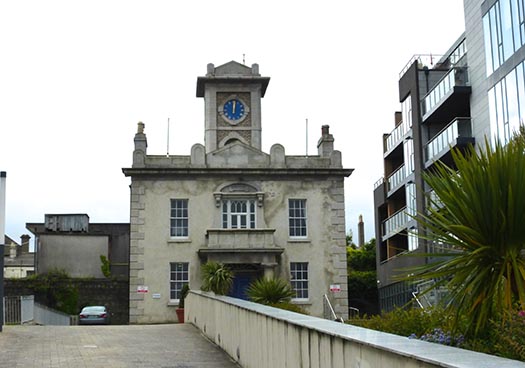
The Harbour Lodge is symbolic of today's Dun Laoghaire, a classical building from an earlier age, but now enclosed by modernity. Photo: W M Nixon
When we get down to the nitty gritty like this, Gerry Dunne is in his element. He's an affable guy, and good company, but I wouldn't like to get into a row with him, as there's steel underneath it all. So in the sedate setting of Harbour Lodge – which he cheerfully admits his opponents and friends have nick-named "Mussolini's Palace" – he's just the man to fight off the brickbats and work his way towards several objectives. But although he actually lives in Dun Laoghaire within walking distance of his office, he's not really into boat and water sports, yet that's no drawback, as personal preferences definitely don't come into it at all as he plans the way ahead.
He makes no bones about admitting that his attitude is strongly commercial. Before taking over the reins at Dun Laoghaire Harbour Company, he was Commercial Director at RTE, a job description which boggles the mind. Before that, he honed his skills in the UK, working for several large Irish food companies. If that gives you a vision of ditzy little artisan cheeses selling in agreeable country shops, then perish the thought – the big Irish food industries provide as tough a business environment as you could imagine.

The many moods of Gerry Dunne.Toughened by a varied and demanding career in business and marketing, he has brought a fresh mind to the problems of making Dun Laoghaire harbour economically viable. Photos: W M Nixon
He joined the Harbour Company in 2009, when talk of Stena's withdrawal was already in the wind. So he got Dun Laoghaire moving towards the cruise liner market in a small way, with the miniature 53-passenger Quest in 2011. Finding Quest an in-harbour berth was no problem, and she provided invaluable information on what Dun Laoghaire can provide as a USP for discerning cruise liner passengers. For Quest's rather specialist group, it was the easy access to the Wicklow Hills and particularly Mount Ussher Gardens, and they definitely didn't want to have to travel through Dublin City to get there.

The mini liner Quest – seen here in the Arctic - began the programme of attracting cruise ships to Dun Laoghaire in 2011
So far so good, but Gerry Dunne really struck gold when he started going to the cruise liner fairs in America and Europe. Gradually he built up a useful network, and again he struck gold when he got a report on the potential attractions of Dun Laoghaire from the Vice President (Itineraries) of one of the biggest American cruise liner conglomerates. Asked to sum up in one word the attraction of the Dun Laoghaire for visitors coming in from sea, her answer was: "Serenity".
We've become accustomed to Venice being talked of as The Most Serene Republic - The Serenissima. But it makes you sit up and take notice to hear of Dun Laoghaire being so described by a tough American businesswoman. Yet that's the impression the waterfront area, with its combination of the old yacht clubs, the station, the Town Hall and the Royal Marine Hotel, apparently makes on seaborn visitors from cruise liners, even if their liners are at present anchored outside the harbour and they have to be ferried in to land by ship's tenders. It seems they can blank out the less attractive buildings, and are left with the abiding impression of relaxed elegance with an easygoing way of life.
This takes a bit of getting used to, as it's so much at variance with the perception in Ireland of Dun Laoghaire as a place where they'd argue over anything and everything all the time, while just up the street there's the real problem of the dreary array of boarded-up shops. But like it or lump it, here it is folks – the reality is the yacht clubs and other other historically significant and stylish buildings of the Dun Laoghaire waterfront area – including the pleasantly under-stated Victorian residential terraces - are the town's greatest tourist asset.
Quite what some of the more senior members of the yacht clubs will make of that we can only guess, but the word is that the clubs have indicated that they'll be prepared to welcome some cruiser liner guests to their premises at pre-arranged times. So perhaps we should see the cruise liners as no more than extra-super super yachts......And there's no doubt that many rugged sailing folk from Dun Laoghaire are themselves only too happy to tootle off on a cruise liner when the peak of the sailing season is over.
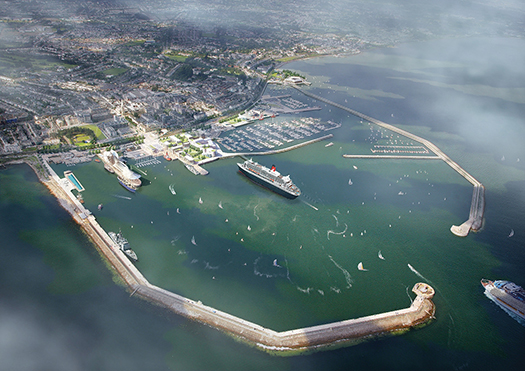
The artist's impression was just that – an artist's impression. If the new berth goes ahead, cruise liners will actually have their sterns towards the town.
But what is the reality if the new berth is agreed? Well, you can forget about your artist's impressions showing a liner facing the town. Space will be restricted, so the liners will come in stern first, thereby enabling them to make an elegant departure for the benefit of crowds down the end of the piers, which could become a popular occurrence.
The new liner pier will be as short as possible, though it will have an underpass for small craft, while the bows of the ships themselves will be held in place by dolphins, as was the HSS ferry. If you think that getting into this berth will involve impossibly ticklish manoeuvring, consider this recent photo of the three Cunard Queens up close and friendly in Southampton, and note that there's no lack of small craft nipping about among them.
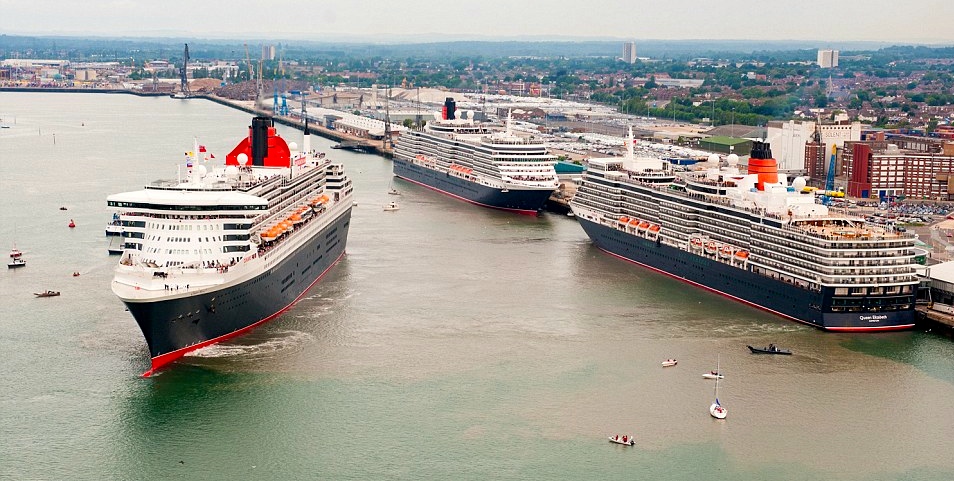 The three Cunarders can manoeuvre unaided at close quarters even with several small craft nipping about their heels, as seen here in Southampton
The three Cunarders can manoeuvre unaided at close quarters even with several small craft nipping about their heels, as seen here in Southampton
One of the other drawbacks about the current setup, with the ships anchoring off and people disembarking in the Coal Harbour, is that there's very little space for buses to move about, but the present waterfront marshalling yard left behind by the exit of Sealink will greatly relieve that problem if the new berth is built. At the moment, it is planned that passengers will walk the short length of the pier to reach their buses, but my own feeling is that the pier should be made a bit wider with a turning circle in order that passengers may board their buses almost directly from the ship, for we're not talking long distance athletes here.
That said, those who are fitter can come and go as they please, with the town within easy reach, whereas being anchored off can cause cabin fever. In other words, if Dun Laoghaire is going to have a cruise liner berth, let it be done properly – half measures involving long walks to buses just won't do, but equally for those who do walk, the town must feel accessible and welcoming.
As to the amount of space the ship will take up in the harbour, that will vary from ship to ship, but some are indeed enormous. And their wind-deflecting presence will certainly add an extra interest to in-harbour dinghy racing. As for the interest of the in-harbour racing for the visitors on the ship, that in turn will all be part of Dun Laoghaire's colourful charm, for which their ship will provide a grandstand view.
In line with that, we should remember that the leading in-harbour class, the historic Water Wags, have only just returned from showing themselves off at Morbihan Sailing week in France. Thus they'll scarcely be unduly bothered about providing a source of fascination for passengers on cruise liners, some of whom will probably be former dinghy racers themselves.
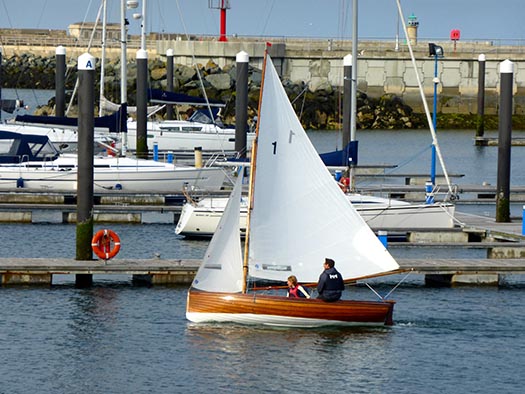
The Water Wags find it easy to sail freely within Dun Laoghaire Marina on their way out to race in the main harbour, so their only problem with a cruise liner berthed in mid-harbour will be the effect it has on wind flow. Photo: W M Nixon
But what the in-harbour dinghy racers are already becoming happily accustomed to is the newly-emptied eastern half of the harbour, with space now provided where boats used to moor. And this area will not be at risk from maneuvering cruise liners – there's not the depth for them. Finally, as to the height or otherwise of the ships in relation to other structures in Dun Laoghaire, I think we've been righteously indignant about this on a mistaken premise – since the new library was pushed into place, all bets about skyline heights and an elegant relationship with other waterfront buildings are clearly off.
So if the sailing and boating community can be more accepting of the cruise liners which will ultimately provide a real source of income to maintain the harbour which makes their activities possible, what can they expect in return?
They're in a strong negotiating position. After all, the Harbour Company's research has shown it is the comfortable presence of the yacht clubs which underpins this vision of serenity which is Dun Laoghaire's most appealing attraction for the kind of people who enjoy the cruise liner experience. So it's very much in the Harbour Company's interest to keep the clubs in good health.
By today's standards, the Royal Irish YC is thriving, thanks in no small part to its location within the marina against whose creation, ironically, the club fought tooth and nail. But the other three clubs – the Royal St George, the National, and the Dun Laoghaire MYC – are blighted by the limited and relatively unsheltered pontoon berthing at their clubhouses.
It may well be – and I'm only guessing – that the Marina Company's agreement with the Harbour Company includes a clause that these three clubs are not allowed to have their own adjacent marinas. But if such a clause exists, then it should be deleted for the greater good of the harbour and the vitality of the waterfront in general, and the three clubs should be facilitated in providing 150-boat marinas – with proper breakwaters for the George and National - in front of each clubhouse.
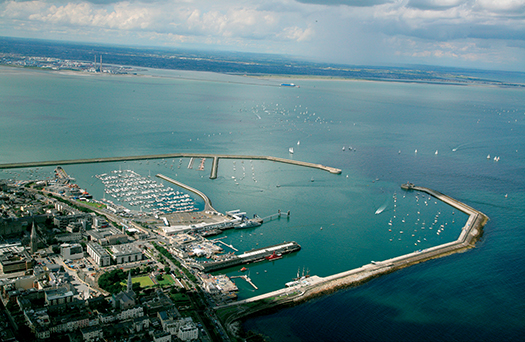
Dun Laoghaire from the southeast. If the new cruise liner berth is installed at mid-harbour, a longterm plan could be the installation of breakwaters in front of the Royal St George YC and the National YC in the foreground to shelter two new 150-boat marinas, as the location of the Royal Irish YC within the main marina gives it an unfair advantage in providing facilities for its members.
As to how Dun Laoghaire town can benefit, that's another matter altogether. The much stronger income and improved employment going through the Harbour Company will undoubtedly be a tangible good, though how seasonal it will be – with liners expected only between April and October – remains to be seen.
But personal expenditure by cruise liner passengers in the town is an imponderable. In fact, some cruise liners in the popular sunshine destinations are notorious for disembarking guests who feel that they made their total investment with the purchase of the ticket back home, so they don't plan to spend any more.
The historic little Venetian city-port of Dubrovnik on the Adriatic – which doesn't have a proper liner port – recently banned cruise liners from coming anywhere near the place, as their thousands of passengers made the narrow streets very uncomfortably crammed at peak times, yet the average expenditure ashore in Dubrovnik by each cruise liner passenger was precisely €6. There's food for thought. But we will of course get a better class of cruise liner passenger in Dun Laoghaire...
International Peer Review Confirms Aids to Navigation Requirements for the Irish Coast to 2020
#lighhousereview – The General Lighthouse Authorities for the UK and Ireland have now completed their latest 5 yearly comprehensive review of Aids to Navigation (AtoN) requirements for the waters around Ireland and the United Kingdom. User Feedback, Automatic Identification System (AIS) traffic analysis, Targeted User Consultation, Navigational Significance Assessments, Risk Assessments and Peer Review were all used to help define ongoing User Requirements. The full document is downloadable below as a pdf document.
The following principles were applied during the review process to ensure consistency:
• Generally having one light in view is acceptable
• Generally a max range of 18 Nautical Miles is considered sufficient for most lights
• If practical there can be a reduction in amount and diversity of flash characters on lighthouse lights
• Leading Lights remain important
• Sectored Lights remain important
• Synchronised and Sequential Buoy lights can be used more
The decisions were made following consultation with users and representative organization's across the whole spectrum of the industry from large SOLAS vessels to leisure users and the fishing sector.
A summary of the changes that Irish Lights will make is as follows:
• Establish RACON at the Foyle Buoy due to increased large vessel traffic
• Open negotiations to upgrade to general AtoN status' Bloody Foreland Light as analysis has shown General Traffic is transiting the area
• Disestablish the Pollock Buoy as the Power South Cardinal has made this Buoy redundant
• Replace the Briggs Port Hand Buoy with a North Cardinal Buoy to provide a clearer indication of the position of the danger
• Establish a Buoy in place of the Unlit Carrigavadra Beacon
• Sequence Buoyage at the entrance to Rosslare
Capt. Harry McClenahan Navigation Manager at Irish Lights said "The rate of technological changes in navigation support systems and materials has had a significant and positive effect on the services that Irish Lights provides to the Mariner, allowing for higher performance yet lower power demands from our stations. We are in the embryonic phase of the evolution of digital systems which are already starting to shape the future of marine navigation and communications. To ensure that safety of persons and property and environmental protection remain as the main focus for future navigation services we use our resources, experience and competency to explore and trial new systems and materials."
The 2015 Aids to Navigation Review was launched yesterday at the Joint Users Consultative Group Meeting in Trinity House London. The changes will be phased in over the coming years and will be fully promulgated in advance by Notice to Mariners.
When Irish Lights Are Shining in the Scilly Isles
#IrishLightsScilly – ILV Granuaile, the Commissioners of Irish Lights aids to navigation tender is understood to have carried out work for the first time within waters of the Isles of Scilly, writes Jehan Ashmore.
The tender's call in this week of St. Patrick's Day followed a departure from Irish waters in which she has responsibility around the entire coast of this island.
It was when she headed through St. Georges Channel is where she passed in the opposite direction the containership Coronel. The only vessel that operates between the Irish and Welsh capitals had departed Cardiff bound for Dublin.
ILV Granuaile has worked previously off the UK's South West coast but prior to this area she headed into the Bristol Channel to call into Swansea Docks where Trinity Lights have a depot in King's Dock. Likewise of Irish Lights, the general lighthouse authority (GLA) of Trinity House has responsibility for the safety of shipping and mariners in waters off England, Wales and the Channel Islands.
Following an overnight call, she was off Porthcawl. She then took a longer passage across the Bristol Channel to pass off Ilfracombe and offshore of the estuary leading to Appledore. This is where the Navy Service latest newbuild OPV90 was built by Babcock Marine. As reported before, James Joyce had completed recent builders sea-trials.
So why was ILV Granuaile working off the Scilly Isles, the reason is that one of the trio of Trinity House vessels, THV Patricia is undergoing her special five-year drydock in Hull. Last year ILV Granuaile underwent a more extensive 15 year Special Survey and Drydocking' at Cork Dockyard.
During her Scilly stay and offshore of Hugh Town on the largest island is where the main freight-only cargship, Gry Maritha was operating.
Both vessels this afternoon departed for the mainland, with the cargoship calling within the small confined dock of Penzance Harbour. Whereas the Irish lighthouse tender took up a position offshore of the Cornish port.
In January, Northern Lighthouse Board, the third GLA, deployed NLB Pole Star that involved a brief call to Dun Laoghaire Harbour. The call of the tender which otherwise has juristriction along with NLB Pharos of Scottish and Manx waters was concurrent to the 'Granuaile' making a more recent call to Cork Dockyard last month.
Second 'Spar' Trial Buoy Deployed on The Irish Sea
#SPARbuoys – The second of a pair of Finnish Spar tube type buoys has been deployed by the Commissioners of Irish Lights at the Bennet Bank station on the outer fringes of Dublin Bay,writes Jehan Ashmore.
ILV Granuaile, the aids to navigation tender carried out the deployment on Tuesday, a day after the first Spar buoy (a type used in the Baltic Sea) was deployed further south in the Irish Sea at the West Blackwater station off the Wexford coast.
CIL in co-operation with Meritaito Ltd, a Finnish state company are carrying out a comparison programme for performance and survivability tests on the spar buoys at the two Irish Sea stations and which are part of the Dublin Bay Digital Diamond Project.
The slim profile of Spar buoys, are particularly well suited to the Baltic's ice conditions, though they can suffer from conspicuity problems when compared with conventional buoys.
By deploying the Spar buoys, the Irish Sea trials will determine visible and radar conspicuity performance of the slimmer spar structures in comparison to the profile of the existing conventionally shaped buoys.
Trails are expected to run for 12 months and mariners are advised to maintain a safe distance from these buoys during the trial timeframe.
The Spar buoys are of the same light and daymark display as those of the existing buoys will be established in close proximity to both of the Irish Sea stations.
To consult the Notice to Mariners, showing Spar buoys locations, CLICK HERE.
Commissioners of Irish Lights Chart First Permanent Virtual Aid to Navigation in Irish Waters
#lighthouses – The Commissioners of Irish Lights (CIL) has the first permanent Virtual Aid to Navigation charted in Irish Waters on the 5th June 2014. The port hand Virtual Aid to Navigation was established at the entrance to Belfast Lough on the North East Coast of Ireland. This was in response to a newly reported shoal depth of 8.0 metres at the Rigg Bank.
CIL explored various options to ensure the shoal depth was addressed correctly. One option was to place a buoy to mark the pinnacle depth. However, after completing a Risk Assessment and extensive Automatic Identification System (AIS) analysis, it was clear the buoy would introduce a new danger in the relatively deep water. As a result, the port hand Virtual Aid to Navigation was chosen and deployed approximately half a nautical mile east of the position of the new pinnacle depth on the 20th November 2013.
Deirdre Lane, Navigation Policy Officer in CIL commented "It was found that deep draft vessels which need to have the pinnacle depth highlighted the most, are those that have the capability for a Virtual Aid to Navigation to be displayed on their on-board systems. In this unique set of circumstances, it was clear the Virtual Aid to Navigation was the best option".
One of the functionalities of AIS is that a land based AIS station can be used to transmit the position of an AIS Aid to Navigation that does not physically exist in the water. It is represented as a digital symbol on the ships Radar, Electronic Display and Information System (ECDIS) or Integrated Navigation System.
In order to bring the Virtual Aid to Navigation to the Mariners attention, it was officially mapped on navigational charts by the UKHO at CIL's request on 5th June 2014. As a result, CIL is responsible for the first permanent charted Virtual AIS Aid to Navigation in Irish waters.
Former Irish Lights Dun Laoghaire Harbour Based Buoy-Tender Sports New Shannonside Colours
#BuoyTender - Puffin, a former Commissioners of Irish Lights (CIL) buoy-tug tender which spent a career of almost three decades in Dun Laoghaire Harbour has recently been spruced up in new colours for current owners Shannon Workboats, writes Jehan Ashmore.
Puffin was very much a 'workhorse' for Irish Lights Dun Laoghaire based marine depot from where the vessel towed countless buoys back and forth to the various anchored 'lighthouse' tenders among them Atlanta, Granuaile and Gray Seal.
Arguably such workhorses can be easily forgotten or disregarded in a task perhaps perceived as mundane yet the role of the Puffin was an integral component in ensuring the operations of CIL.
The work of Puffin was vital bearing in mind the countless aids to navigation that dot around our island to assist safe passage not just to seafarers and ship cargoes but also passengers and leisure users too.
The Commissioners had Puffin custom-built from David Abels Boatbuilders of Bristol in 1984. It is understood that the small vessel of 12.4m long, beam of 3.8m and 1.5m draught was the last vessel launched from the Albion Dockyard.
When she was sold in 2011, the 24 gross tonnes vessel made her repositioning delivery voyage from Dun Laoghaire to the Shannon Estuary. The first leg to Baltimore took more than 30 hours and from where she took on bunkers before continuing on the final 20 hour-leg to Foynes.
She alongside Shannon Workboats fleetmate Islander are 'lines-boats' contracted to Rusal Aughinish Alumina, the largest alumina processing plant in Europe. Both workboats provide assistance in transferring mooring ropes between bulk-carriers docking and departing the double berth jetty.
The outer 285m berth can handle 90,000dwt vessels at depths of 12.4 metres and the inner 180m berth is for 40,000dwt ships in waters of 11 metres.
Examples to the type of bulk-carriers both large and small calling to Aughinish Jetty as previously reported on Afloat.ie are the 2009 Japanese built Panama-flagged Aom Julia, the 76,596dwt which was discharging bauxite. On the adjacent berth the South Korean built Arklow Mill of 14,990dwt was loading alumina bound for Rotterdam.
The plant's production process involves extracting alumina from imported bauxite that is discharged at the jetty. Approximately 70% of the bauxite originates from Guinea in west Africa and the balance from Brazil. The alumina (totalling 1.924m tonnes in 2012) is discharged from the same jetty for export where it is processed again through smelting into aluminium metal.
The lighthouse vessels are now referred as aids to navigation tenders with the current vessel the 2000-built ILV Granuaile. The 2,635 gross tonne vessel continues to anchor within the harbour's western bight off the West Pier. Instead of the Puffin, the towage of buoys continues to be maintained by smaller sized tenders belonging to the ILV Granuaile.
On a few occasions each year due to Spring tides, this procedure is not required as ILV Granuaile can moor alongside the berth at CIL's joint administration and marine depot.
Among the other tasks Puffin was gainfully employed was in the towage of the larger navigational aids such as Superbuoys and Large Automated Navigation Buoy's (LANBY). In 2010 Afloat.ie reported on the last LANBY.
In addition Puffin was not exclusively confined within the harbour as she would be required to transfer maintenance personnel to the automated Kish Lighthouse and Muglins lighthouse off Dalkey Island.
Her aft deck can handle up to 5–tonnes capacity and has proved useful. For example she loaded dismantled parts no longer required within the structure of the Kish Lighthouse and taken to Dun Laoghaire Harbour.
Puffin not only retains her original name but also her port of registry – Dun Laoghaire which is certainly most unusual to see for a vessel that is not a pleasure craft or yacht.
With the removal of Puffin's former CIL livery of grey hull colour and buff funnel, which also applied to the lighthouse tenders, the last been in this guise was the 1970 built Granuaile.The 2,003grt vessel as previously reported on Afloat.ie serves as Ocean Seeker for Gardline Marine Services based out of Great Yarmouth on the UK's Norfolk coast.
The current 'Granuaile' sports a blue hull likewise to her former fleetmate... the Puffin!
Irish Lights HQ To Welcome The Public For 'Open House Dublin'
#IrishLights - The headquarters of the Commissioners of Irish Lights in Dun Laoghaire is one of the 100 great buildings that will open to the public on the weekend of 4-6 October for Open House Dublin, the annual celebration of the city's architecture and history.
It seems fitting that the head office of the body that administers some of Ireland's most treasured coastal landmarks is itself an architectural wonder, a stunning rotunda of tinted glass ad steel designed by Scott Tallon Walker Architechts that's complemented the Dun Laoghaire waterfront since 2008.
Tours of the building will be on a first come, first served basis: just turn up and look out for Open House Dublin volunteers. See the Open House Dublin website for more.
Beaming Lights Locate All Ireland Lighthouse Trail
#LighthouseTrail - As previously reported last week the first ever All Ireland Lighthouse Trail was jointly launched by ministers from north and south at Blackrock Lighthouse, Co. Antrim, one of five lighthouses selected for development along the northern coastline.
The All Island Lighthouse Trail project, led by the Commissioners of Irish Lights (CIL), will see these five operational lighthouses also made available for specialist tourism accommodation and attractions. The project has the support of the European Union INTERREG IVA with funding of €2.5million for tourism and job creation.
To see the location of the lighthouses (including technical information) click CIL's aids to navigation-lighthouse-map. The lighthouses are Blackrock Lighthouse, Rathlin West off Co. Antrim and St John's Point, Co. Down. The remaining lighthouses are both in Co.Donegal, one on Fanad Head and the other lighthouse also named St. John's Point is located near Killybegs.
Lighthouses on Northern Coast to Be Opened to Tourists
#Lighthouses – As previously reported, the first ever All-Ireland Lighthouse Tourism Trail project is being lead by the Commissioners for Irish Lights (CIL).
The project will see key facilities for accommodation and attractions made available along the northern coastline.
As well as creating jobs, the €2.5m project will help boost the local tourism industry.
The project, funded by the Special EU Programmes Body, will see 60 jobs supported during the construction period and 10 new jobs created when the facilities become operational.
The lighthouses earmarked for the project include Rathlin West, Blackhead on the Antrim coast, St John's Point in County Down, Fanad Head in County Donegal and another St John's Point again in County Donegal. For more on this lighthouse trail project, u.tv/news has a report.
Get Hooked: Calling All Lighthouse Keepers & Enthusiasts
#HookLighthouse – Hook Head Lighthouse which is run by Hook Heritage is in conjunction with the Commissioners of Irish Lights (CIL) delighted to announce their flagship Gathering Event to be held in September.
An exciting weekend is to take place between 13-15 September at the oldest operational lighthouse in the world on the sunny Hook Peninsula in Co. Wexford.
On offer during the three-days there will be a Lighthouse Symposium with guest speakers from all over the world to dinner and dancing, music, free family fun, a magical fireworks display and more.
Irish Lights are to catalogue and document stories from old and preserve the heritage that makes our shores so rich in history.
For further details about the special celebratory Gathering visit this LINK (scroll down for events programme). In addition to finding out more about the work of Ireland's aids to navigations service visit the Irish Lights homepage.



























